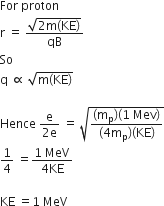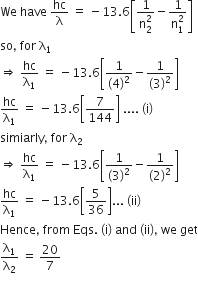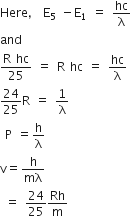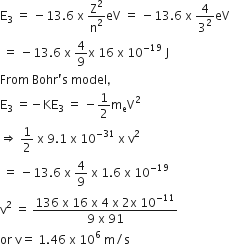A certain mass of hydrogen is changed to helium the process of fusion. The mass defect in fusion reaction is 0.02866 u. The energy liberated per u is (given 1 u =931 MeV)
-
2.67 MeV
-
26.7 MeV
-
6.675 MeV
-
13.35 MeV
C.
6.675 MeV

Sponsor Area
A certain mass of hydrogen is changed to helium the process of fusion. The mass defect in fusion reaction is 0.02866 u. The energy liberated per u is (given 1 u =931 MeV)
2.67 MeV
26.7 MeV
6.675 MeV
13.35 MeV
C.
6.675 MeV

Sponsor Area
A proton carrying 1 MeV kinetic energy is moving in a circular path of radius R in the uniform magnetic field. What should be the energy of an alpha particle to describe a circle of the same radius in the same field.
2 MeV
1 MeV
0.5 MeV
4 MeV
B.
1 MeV

An electron in hydrogen atom first jumps from third excited state to second excited state and then from second excited to the first excited state. The ratio of the wavelengths λ1:λ2 emitted in the two cases is
7/5
27/20
27/5
20/7
D.
20/7
Here, for wavelength λ1
n1 = 4 and n2 =3
and for λ2, n1 = 3 and n2 = 2
An electron of a stationary hydrogen atom passes from the fifth energy level to ground level. The velocity that the atom acquired as a result of photon emission will be




A.


Consider 3rd orbit of He+ (Helium), using non-relativistic approach, the speed of electron in this orbit will be (given K= 9 x 109 constant, Z=2 and h (Planck's constant = 6.6 x 10-34 Js-1
2.92 x 106 m/s
1.46 x 106 m/s
0.73 x 106 m/s
3.0 x 108 m/s
B.
1.46 x 106 m/s
Energy of electron in the 3rd orbit of He+ is
Sponsor Area
Mock Test Series